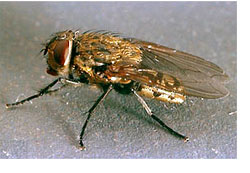 Homeowners are accustomed to swatting flies in the kitchen during the summer months. However, cluster flies make their debut in the autumn when they fly to the sunny sides of homes in search of protected over-wintering sites and may be found flying about inside, often in great numbers, throughout the winter. These flies are not reproducing within the structure, but become active on warm days and crawl out of wall voids and attics in a confused attempt to go back outside.
Cluster flies are thought to be native to Europe and may have found their way to North America in the ballast of ships containing soil and the cluster fly host, earthworms.
Homeowners are accustomed to swatting flies in the kitchen during the summer months. However, cluster flies make their debut in the autumn when they fly to the sunny sides of homes in search of protected over-wintering sites and may be found flying about inside, often in great numbers, throughout the winter. These flies are not reproducing within the structure, but become active on warm days and crawl out of wall voids and attics in a confused attempt to go back outside.
Cluster flies are thought to be native to Europe and may have found their way to North America in the ballast of ships containing soil and the cluster fly host, earthworms.
Adult cluster flies are slightly larger than the common house fly, Musca domestica . They are dull-gray with black markings and have golden-yellow hairs on the thorax, which can give the appearance of a golden sheen. The hairs are more numerous on the under side of the thorax between and near the legs.
There is no effective way to control the larval stage of these flies because they develop in earthworms. The most effective long-term control in homes attractive to the over-wintering adults is to eliminate as many entry points in the walls and roof of the structure as possible. Residual pesticide applications can be applied to the exterior surfaces of structures in late summer or early fall to reduce the number of adults entering the home. Large accumulations of flies already in the structure can be removed with a vacuum cleaner. Large numbers of dead flies may lead to secondary infestations of larder beetles or carpet beetle larvae developing on the dead flies. Exclusion, if possible, provides the best permanent control.